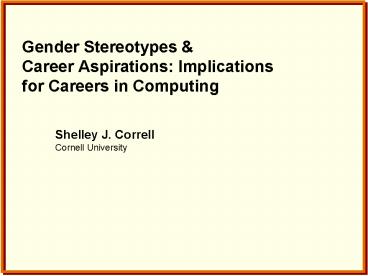Gender Stereotypes - PowerPoint PPT Presentation
1 / 25
Title:
Gender Stereotypes
Description:
Gender differences in ability. Gender differences in career decisions. Testosterone ... Bogus task (test of 'contrast sensitivity' ability) ... – PowerPoint PPT presentation
Number of Views:2923
Avg rating:3.0/5.0
Title: Gender Stereotypes
1
Gender Stereotypes Career Aspirations
Implications for Careers in Computing
- Shelley J. Correll
- Cornell University
2
(No Transcript)
3
?
?
TestosteroneBrain laterality
Small test score differences Varies cross-
nationally
Large differences
4
- But how?
- Stereotypes impact task performance and the
standard we use to evaluate performance
information.
5
(No Transcript)
6
How do stereotypes impact performance?
(Stereotype threat)
- Main finding is that negative stereotypes lead to
decreased task performance. - When salient, stereotypes interfere with working
memory capacity. - The effects are larger for higher performers.
- When high-powered people fail
- Working memory and chocking under pressure in
math. Beilock and Carr, 2005
7
How do stereotypes impact performance?
(Stereotype threat)
- The effects often occurs out of awareness.
- Neural basis of stereotype-induced shifts in
womens mental rotation performance. Wraga,
Helt, Jacobs and Sullivan, 2006 - Stereotype threat, inquiring about test takers
ethnicity and gender and standardized test
performance. Stricker Wood, 2004
8
How do stereotypes impact performance?
(Stereotype threat)
- The effects are situationalwhen beliefs that are
salient change, so do performance outcomes. - Stereotype susceptibility Identity salience and
shifts in quantitative performance. Shih,
Pittinsky Ambady, 1999 - Signaling threat how signaling cues affect
women in math, science and engineering settings.
Murphy, Steele and Gross, 2007
9
Stereotype threat summary
- Negative stereotype about ones own group, when
salient, leads to lower performance, controlling
for actual ability level.
10
How do stereotypes impact self-assessments?
- Stereotypes also impact the standard we use to
decide whether our performance indicates that we
have sufficient ability. - Central idea is that when you know that others do
not expect people like you to be good at a
given type of task, you judge your own
performance by a harsher standard.
11
(No Transcript)
12
Constraints into preferences(Correll, 2004
American Sociological Review)
- 80 undergraduates40 males, 40 females
- Bogus task (test of contrast sensitivity
ability) - Performance feedback held experimentally constant
- Dependent variables
- Ability standard
- Self-assessment of task competence
- Future aspirations
- Key independent variable
- Gender belief associated with task
13
Stereotypes and ability standards(Correll, 2004
American Sociological Review)
14
How do stereotypes impact self-assessments?
- If you judge your performance with a harsher
standard, you will make lower assessments of your
own task ability.
15
Stereotypes and self-assessments(Correll, 2004
American Sociological Review)
16
Self-assessments emerging aspirations
(Correll, 2004)
- Male participants reported significantly higher
aspirations for paths requiring ability on the
experimental task in conditions where they had
heard that men have more task ability. - No gender differences in aspirations were found
in conditions where participants heard that
gender was unrelated to task ability. - Situationalwhen beliefs in setting change, so do
ability standards, self-assessments, and
aspirations.
17
Why a laboratory experiment?Why a bogus task?
- Rules out competing supply-side explanations
that women simply have less task ability and that
women naturally are less interested.
18
Problems with aptitude and interest
explanations
- Aptitude explanations are either incorrect,
limited and/or intractable. - Interest explanations ignore the fact that
situational factors influence individuals
interests. - They suggest no avenues for change.
19
Back to the real worldAn application to the
path to math
- Using nationally representative data from over
16,000 students in the U.S., we compare how boys
and girls with equal mathematical ability assess
their own mathematical competence. - Gender and the career choice process. Correll,
2001
20
An application to the path to math (Correll
2001)
- Mathematics is stereotyped as a masculine domain.
- Consistent with previous study, male students
were found to assess their mathematical ability
higher than their equal ability female
counterparts did. - Situationalfemale students were found to assess
their verbal ability higher than their equal
ability male counterparts.
21
An application to the path to math (Correll
2001)
- Higher self-assessments of mathematical ability
increased the odds that students enrolled in high
school Calculus and chose a college major in
science, math or engineering.
22
Implications
- If left unchecked, gender stereotypes will
contribute to the under-representation of women
in technical fields.
23
What can be done? Underlying principles to keep
in mind
- Stereotypic biases often occur out of
consciousness. - Biases are more extreme in uncertain settings.
- The impact of stereotypes change when beliefs in
the local setting change.
24
What can be done? What doesnt work?
- Must change gender beliefs about gender and task
competence that exist in an organization not just
individual womens beliefs (i.e., avoid fixing
women approaches), because the biasing effect of
stereotypes has a demand-side counterpart.
25
What can be done? Organizations need to
- Control the message What are the gender beliefs
that are operating in the organization? How does
the organization present itself? - Make performance standards clearer and
communicate them clearly. - Hold gatekeepers accountable for gender
disparities.































